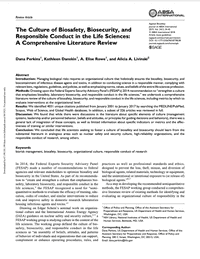The Culture of Biosafety, Biosecurity, and Responsible Conduct in the Life Sciences: A Comprehensive Literature Review
[Culture of Biosafety and Biosecurity: A Literature Review]
This paper argues that organizations must foster an organizational culture of responsibility to ensure that biological risks are managed and life science research is conducted responsibly. The authors encourage further investigations into the effectiveness of training and interventions.
SUMMARY
This article draws upon the Federal Experts Security Advisory Panel’s (FESAP’s) 2014 recommendation to “strengthen a culture that emphasizes biosafety, laboratory biosecurity, and responsible conduct in the life sciences.” FESAP also called for semi-quantitative methods for evaluating the effectiveness of training, education, and codes of conduct on improving safety in research laboratories. FESAP provides guidance to the United States Secretaries of Health and Human Services and Agriculture and the Attorney General.
Dana Perkins, Kathleen Danskin, Elise Rowe, and Alicia A. Livinski, all members of the FESAP working group, authored the article. The authors conducted a comprehensive literature review of the current culture of biosafety, biosecurity, and responsible conduct in the literature, including metrics for evaluating organizational interventions intended to improve that culture.The authors identified three recurring themes: dual-use and/or biorisk management education and training; social responsibility in science, research ethics, and related education and training; and codes of conduct. The authors observe that there has been little assessment of the effectiveness of education and training interventions in the life sciences, but that there is a body of work discussing the effectiveness of Responsible Conduct of Research (RCR) training.The authors conclude that life scientists seeking to improve their organization’s culture of biosafety and biosecurity should draw on this RCR literature as well as analogous areas such as nuclear safety and security.
The article was published in 2019 in Applied Biosafety, the journal of ABSA International (ABSA). ABSA was founded in 1984 to promote biosafety as a scientific discipline, provide a professional association that represents the interests and needs of biosafety practitioners, and to provide a forum for biosafety information. As of September 2021, this article and Applied Biosafety are only available in English. This article may be useful for any one interested in strategies for evaluating and improving the culture of biosafety, biosecurity, and responsible research in their institutions.


..png)
